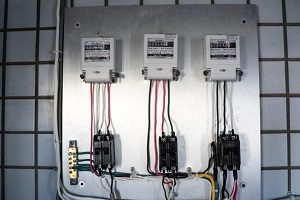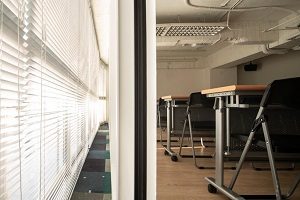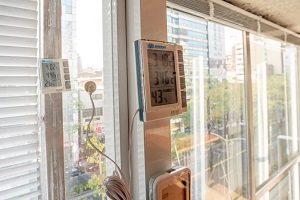Transforming the Second Home of Office Workers
By Chen Yi-zhen (陳怡臻)
Photos by Tzu Cheng Liu (劉子正)
Abridged and translated by George Chen (陳纘強)
Transforming the Second Home of Office Workers
By Chen Yi-zhen (陳怡臻)
Photos by Tzu Cheng Liu (劉子正)
Abridged and translated by George Chen (陳纘強)
The majority of office workers in Taiwan can only make do with poorly ventilated working environments. Forty-five percent of them surveyed expressed that their working environment has made them less healthy both mentally and physically.
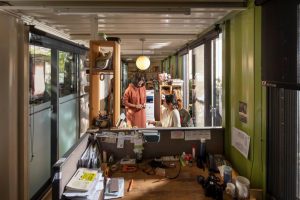
Wutong Foundation converted a cargo container into a comfortable, airy and light-filled office for her workers.
More than eight hours a day, at least five days a week, most of us spend more time in the office than we do at home. Thus the office environment is critical to one’s well-being. However, apart from the modern state-of-the-art buildings that house premium companies, most offices are located in old buildings with poor ventilation, inadequate lighting, and deteriorating facilities.
How can we expect employees to be engaged and productive when they feel physically and mentally uncomfortable?
“Since I resigned and departed from the office I have worked in for years, my coughing and sneezing have automatically stopped.” Lin Dai-ling (林黛羚) who authored the book “Green Office” (好感辦公室:會說故事的空間) said she was compelled to write the book as she was once a victim of poor office environment. Spending long periods of time cramped in a poorly ventilated office, ailments such as coughs and dizzy spells repeatedly recurred without complete cure in sight. It was after she resigned and entered a better working environment that the ailments were alleviated.
Lin believed that “If your work environment is substandard with poor ventilation and lighting, you are dwelling in a sub-optimal environment in most of your waking hours. Eventually, your mind and body will be perpetually suspended in an unhappy state.”
We all know that a poor working environment drains productivity, and a comfortable space can help stimulate workers’ creativity and spur organizational competitiveness. When workers spend at least one-third to one-half of their time each day in the office, improving the office environment should go beyond just beautifying the façade. Priority should be given to “function” and “comfort” rather than just focusing on novel and beautiful designs.
Qiu Ji-zhe(邱繼哲), chairman of Green Comfort Health Architecture (綠適居協會), has extensively surveyed and transformed many working spaces. He shares that while many of us know we need to install water filters to sieve impurities, few pay heed to improving the quality of the indoor air we inhale. Qiu asserts, "The fundamentals of improving a space should start with air quality."
The basic principle for better air is to encourage ventilation. That is, we need to allow space to inhale fresh air, and to discharge heat, moisture and exhaust air. Through his work, Qiu finds that many fallaciously think that air ventilation can be achieved by closing the door and turning on the air condition. However, a closed air-conditioned space lacks ventilation, circulating the same moisture and air which eventually accumulates high concentration of carbon dioxide, making its inhabitants drowsy. “For those who need to stay in a closed air-conditioned office over extensive periods of time, their productivity and health will definitely be impacted.” Qiu advised that the easiest way to promote ventilation is to open upper windows when we turn on the air condition, allowing exhaust heat to ascend and be discharged.
A foundation, Citizen of the Earth, Taiwan (地球公民基金會)(hereinafter referred to as the “foundation”), which recently opened its headquarters in Kaoshiung, improves its office air by replacing “air-conditioning” with “ventilation.” The foundation office is located in a building with glass curtain design and only one functional window per floor. While the glass curtain emits strong sun lights, air quality is poor as there are no ventilation ducts to improve circulation.
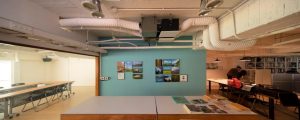
Citizen of the Earth, Taiwan’s headquarter in Kaohsiung is housed in an old office building without central air conditioning. A work space transformation team has turned the space into a well-ventilated, air-filled model office space.
Fresh Air for Employees
"The original state here can be regarded as one of the worst offices in Taiwan!" Li Han-lin (李翰林), the foundation director, describes the office condition before the transformation. He said that the office was extremely hot and suffocating due to the lack of ventilation. During hot summers, one can imagine it will only be more uncomfortable to be in the space, not to mention working inside there for a long period of time. "The small window is just not enough. We can only rely on large air-conditioning to relieve the sultry heat. However, the problem is that in addition to the noise emitting from the air conditioning, fresh air cannot flow in and the heat from the sun cannot be discharged. To cool down the office, we would have to turn up the air conditioning, which would result in high electricity consumption. It is a very energy-intensive and vicious circle."
However, Li said that as the office space is sponsored by donations to the foundation, they want to make the best of the space to show their appreciation. The foundation brought in Qiu, an expert in construction and environmental control, to execute an extensive physical transformation of the office to improve the environment.
"Compared to residential homes, there are more electrical devices in the office environment such as photocopiers, printers, fax machines and computers. The enormous amount of heat generated from these devices not only makes workers dizzy and develop coughing bouts, they are also the root cause of many diseases."
Qiu explained that not only do these devices dissipate heat, the ink is also dispersed in the air. In addition, as industrial paints used in inks contain toxic chemicals, they add to pollutants that are invisible to the naked eye. For the foundation, controlling air quality, promoting ventilation, and strengthening insulation are three of the most important points of focus for the office transformation.
First of all, a ventilation fan was installed to introduce outdoor air at the only window opening in the whole floor. In addition, an air filtering device was also installed in the office to ensure that the workers do not inhale pollutants, such as PM2.5 suspended particles. Having clean air is not enough, though. Qiu also introduced an additional circulating fan in each corner of the office, so that fresh air flows evenly in the room to benefit all workers.
As for the glass curtain, an insulation layer with exhaust function was added to block direct heat from the sun and expel heat generated in the office. During the interview, Kaoshiung was experiencing hot weather. We compared the two thermometers inside and outside the insulation layer. The temperature difference was as high as nearly 20 degrees. "With the improved environment, even with the blazing sun outside, we do not need to turn on the air conditioner to work comfortably in the office." Li said.
After the transformation is completed, what standard should be used to determine that the air quality has indeed improved? Various devices such as indoor carbon dioxide detectors and PM2.5 detectors are now available on the market. These instruments can be used to remind people to "open the window", "dehumidify", or “turn on the fan” through various indicators. Having these devices in the office, is just like hiring an assistant to help control the quality of the air for workers in the office.
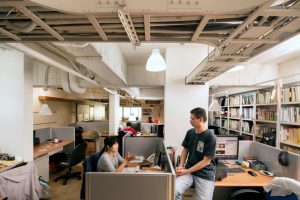
Even during hot summer days, Citizen of the Earth, Taiwan’s office workers can still work comfortably without the need to turn up the air conditioners.
|
Environment change detectors are placed in the balcony to monitor changes in heat, air, and humidity. |
An insulator is used to reduce heat emitting from the glass window in the most poorly ventilated meeting room. |
The thermometers indicate a difference of 10 degrees between the insulator. |
The majority of office workers in Taiwan can only make do with dilapidated and poorly ventilated working environments. Forty-five percent of the office workers surveyed expressed that their working environment have made them less healthy both mentally and physically. How do we help companies to improve their working environment in order to improve their productivity?

Wutong Foundation converted a cargo container into a comfortable, airy and light-filled office for her workers.
More than eight hours a day, at least five days a week, most of us spend more time in the office than we do at home. Thus the office environment is critical to one’s well-being. However, apart from the modern state-of-the-art buildings that house premium companies, most offices are located in old buildings with poor ventilation, inadequate lighting, and deteriorating facilities.
How can we expect employees to be engaged and productive when they feel physically and mentally uncomfortable?
“Since I resigned and departed from the office I have worked in for years, my coughing and sneezing have automatically stopped.” Lin Dai-ling (林黛羚) who authored the book “Green Office” (好感辦公室:會說故事的空間) said she was compelled to write the book as she was once a victim of poor office environment. Spending long periods of time cramped in a poorly ventilated office, ailments such as coughs and dizzy spells repeatedly recurred without complete cure in sight. It was after she resigned and entered a better working environment that the ailments were alleviated.
Lin believed that “If your work environment is substandard with poor ventilation and lighting, you are dwelling in a sub-optimal environment in most of your waking hours. Eventually, your mind and body will be perpetually suspended in an unhappy state.”
We all know that a poor working environment drains productivity, and a comfortable space can help stimulate workers’ creativity and spur organizational competitiveness. When workers spend at least one-third to one-half of their time each day in the office, improving the office environment should go beyond just beautifying the façade. Priority should be given to “function” and “comfort” rather than just focusing on novel and beautiful designs.
Qiu Ji-zhe(邱繼哲), chairman of Green Comfort Health Architecture (綠適居協會), has extensively surveyed and transformed many working spaces. He shares that while many of us know we need to install water filters to sieve impurities, few pay heed to improving the quality of the indoor air we inhale. Qiu asserts, "The fundamentals of improving a space should start with air quality."
The basic principle for better air is to encourage ventilation. That is, we need to allow space to inhale fresh air, and to discharge heat, moisture and exhaust air. Through his work, Qiu finds that many fallaciously think that air ventilation can be achieved by closing the door and turning on the air condition. However, a closed air-conditioned space lacks ventilation, circulating the same moisture and air which eventually accumulates high concentration of carbon dioxide, making its inhabitants drowsy. “For those who need to stay in a closed air-conditioned office over extensive periods of time, their productivity and health will definitely be impacted.” Qiu advised that the easiest way to promote ventilation is to open upper windows when we turn on the air condition, allowing exhaust heat to ascend and be discharged.
A foundation, Citizen of the Earth, Taiwan (地球公民基金會)(hereinafter referred to as the “foundation”), which recently opened its headquarters in Kaoshiung, improves its office air by replacing “air-conditioning” with “ventilation.” The foundation office is located in a building with glass curtain design and only one functional window per floor. While the glass curtain emits strong sun lights, air quality is poor as there are no ventilation ducts to improve circulation.

Citizen of the Earth, Taiwan’s headquarter in Kaohsiung is housed in an old office building without central air conditioning. A work space transformation team has turned the space into a well-ventilated, air-filled model office space.
Fresh Air for Employees
"The original state here can be regarded as one of the worst offices in Taiwan!" Li Han-lin (李翰林), the foundation director, describes the office condition before the transformation. He said that the office was extremely hot and suffocating due to the lack of ventilation. During hot summers, one can imagine it will only be more uncomfortable to be in the space, not to mention working inside there for a long period of time. "The small window is just not enough. We can only rely on large air-conditioning to relieve the sultry heat. However, the problem is that in addition to the noise emitting from the air conditioning, fresh air cannot flow in and the heat from the sun cannot be discharged. To cool down the office, we would have to turn up the air conditioning, which would result in high electricity consumption. It is a very energy-intensive and vicious circle."
However, Li said that as the office space is sponsored by donations to the foundation, they want to make the best of the space to show their appreciation. The foundation brought in Qiu, an expert in construction and environmental control, to execute an extensive physical transformation of the office to improve the environment.
"Compared to residential homes, there are more electrical devices in the office environment such as photocopiers, printers, fax machines and computers. The enormous amount of heat generated from these devices not only makes workers dizzy and develop coughing bouts, they are also the root cause of many diseases."
Qiu explained that not only do these devices dissipate heat, the ink is also dispersed in the air. In addition, as industrial paints used in inks contain toxic chemicals, they add to pollutants that are invisible to the naked eye. For the foundation, controlling air quality, promoting ventilation, and strengthening insulation are three of the most important points of focus for the office transformation.
First of all, a ventilation fan was installed to introduce outdoor air at the only window opening in the whole floor. In addition, an air filtering device was also installed in the office to ensure that the workers do not inhale pollutants, such as PM2.5 suspended particles. Having clean air is not enough, though. Qiu also introduced an additional circulating fan in each corner of the office, so that fresh air flows evenly in the room to benefit all workers.
As for the glass curtain, an insulation layer with exhaust function was added to block direct heat from the sun and expel heat generated in the office. During the interview, Kaoshiung was experiencing hot weather. We compared the two thermometers inside and outside the insulation layer. The temperature difference was as high as nearly 20 degrees. "With the improved environment, even with the blazing sun outside, we do not need to turn on the air conditioner to work comfortably in the office." Li said.
After the transformation is completed, what standard should be used to determine that the air quality has indeed improved? Various devices such as indoor carbon dioxide detectors and PM2.5 detectors are now available on the market. These instruments can be used to remind people to "open the window", "dehumidify", or “turn on the fan” through various indicators. Having these devices in the office, is just like hiring an assistant to help control the quality of the air for workers in the office.

Even during hot summer days, Citizen of the Earth, Taiwan’s office workers can still work comfortably without the need to turn up the air conditioners.
|
Environment change detectors are placed in the balcony to monitor changes in heat, air, and humidity. |
|
An insulator is used to reduce heat emitting from the glass window in the most poorly ventilated meeting room. |
|
The thermometers indicate a difference of 10 degrees between the insulator. |
Beautiful Landscape to Regulate Room Temperature
The impact of air quality affects the health of all people, not just those prone to allergy. According to statistics, seven of the top ten causes of death in Taiwan are closely related to air pollution. The World Health Organization (WHO) has also pointed out that indoor and outdoor air pollution can cause harm to the respiratory tract, causing acute respiratory infections, chronic obstructive pulmonary disease, cardiovascular diseases and even cancer. The problem must not be underestimated.
Wu Sen-ji (吳森基), General Manager of “Herzu” (和築開發), a property development company staffed with 20 people said, “I used to work in an enclosed glass curtain building before. About 12 years ago, when my health deteriorated due to overwork, I started to think about the true meaning of work.” Wu concluded that the first condition for enhancing team creativity and motivation is to provide a healthy, comfortable, and high-quality working space for the workers.
"When our body feels healthy, our mood will be relaxed. Then, naturally, we'll become more motivated. After realizing this, I decided that the office should be relocated to a more environmentally friendly space, instead of the glass curtain building office that even indoor plants could not thrive in," Wu said. Herzu has since moved to an old apartment, now located in the quiet lane of the second section of Fuxing South Road, Taipei City, with a comfortable working space that feels like home.
As Wu is prone to allergies, he develops breathing problems when the air quality is poor. Therefore, the first step in transforming the "new home" was to have windows that could be opened to ensure good ventilation and freshness of the air, while also fitting better interior lighting. Now, the office has a front yard with a lush garden, and floor-to-ceiling windows that can be opened. "Employees can breathe fresh air in any corner of the room, and they can see the garden outside the floor-to-ceiling window," Wu remarked.
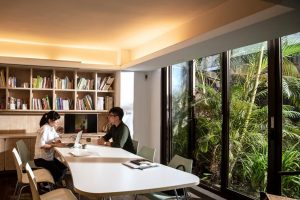
Housed in an old apartment with narrow alley, Herzu, a property development company, introduced floor-to-ceiling glass doors overlooking a lush garden, allowing office workers to receive natural fresh air and enjoy the serene scenery.
"The beautiful garden and leafy plants effectively help lower the indoor temperature." Wu explained that ventilation was poor as the office is located in an apartment hidden in a narrow lane. During the hot and humid summer, the waterfalls and lush vegetation walls in the garden not only effectively cool down the office, the design also prevents outdoor hot air from entering the office, thus forming double insulation. The building team once tested the temperature of the front yard wall when the outdoor temperature was as high as 44.6 degrees. The indoor temperate recorded only 34.6 degrees. Air conditioning is only needed between noon and 2 pm.
When external windows cannot be installed, using ventilation devices would be the next best solution. Especially for small and medium-sized offices, toilets and kitchens are prone to accumulate moisture and fumes. The Herzu office follows this advice by installing ventilation fans and ventilation ducts on the ceilings of the windowless kitchen and toilet to allow such places to be able to breathe.
In addition to the air quality, Wu also paid attention to the ergonomic quality of the chairs and tables as well as the lighting. He observed that many offices tend to use pale fluorescent lamps (color temperature greater than 6500K), which can cause both visual and physical fatigue to office workers. "Just by softening the lighting, we can make the environment more comfortable and thus enhance work performance.” At the same time, Wu puts special emphasis on the harmony between space and comfort, be it in the dining area, the rest area or simply the height of the office chair. They are all aligned, ensuring that employees can see the greenery of the garden at any time, and more importantly, to reduce the visual fatigue caused by long hours of concentration at work.
Leverage the old to create the new
Commercial endeavors in Taiwan have always been dominated by small and medium-sized enterprises (SME), and a majority of them house their offices in old residential properties like the one Herzu is housed in. According to the statistics provided by the Ministry of Economic Affairs, Taiwan’s SMEs account for 97.73 percent of all enterprises in the 21st century, and SMEs account for 72.5 percent of the national employment. At the same time, more than 60% of Taiwan's existing residential properties are over 40 years old. The data suggests that if we do not properly maintain old properties, they will age rapidly, and also affect the performance of SMEs.
"Sometimes, space transformation does not necessarily require massive expenditure. As long as we are receptive to the needs and implement the appropriate solutions, the house can easily be transformed." Miky, who once worked in a renowned accounting firm in Taipei, self-studied to personally transform an old property into a well-ventilated and energy-saving work space.
Eight years ago, after working in a metropolitan area commercial building for six years, Miky felt that her family home in Tainan was deteriorating rapidly due to a lack of ventilation and too much clutter. Although her aged family members knew their living conditions were undesirable, they had neither the resources nor the capability to transform. As Milky has always been interested and involved in interior renovation projects, she decided to take on the renovation herself when she returned to her home town to start her own business. Through the transformation work, she has discovered the wisdom of the original architects and revived the original structural function.
"In the past, people were very ingenious in factoring the climate and the surrounding environment into a building design and structure. This wisdom has been forgotten or just neglected over time." At the beginning of the transformation, Miky thought that the house was poorly ventilated because of the poor design used in the early years. However, when she looked at the blueprint, she discovered that the architects at that time put a lot of focus on ventilation. Apart from the stairwell itself, there were ventilation ducts built throughout the entire house. Even the confined basement was designed to have vents and exhaust fans.
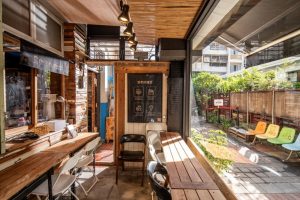
Converting Old Apartment into “Green” Space– Young entrepreneurs convert an old apartment into a working space, with a section rented to a hair salon and the rest of the space used to sell self-made ice cream. Trees planted in the backyard reduce heat and pollution, and also helps to beautify the space.
Upon this discovery, Miky decided to "leverage on the old to create the new" by revitalizing the original ventilation ducts. "As long as they are still functional, they can promote air convection and improve the environment for those working and living inside the house," she said confidently.
Miky first emptied the objects that cluttered the vents, allowing the windows in the vents and stairwells to function again. "This resonates with the wise saying that when we can breathe easily, we'll naturally become more energetic." When the ventilation ducts were cleared, the indoor temperature could be controlled more easily. Now, even when the weather in southern Taiwan is hot and her studio is in a narrow alley, there is no need to install too much air-conditioning. One of the air-conditioning ports on the first floor studio was even transformed into a ventilation duct by Miky. By improving air circulation, the basement warehouse is also no longer humid, and the objects inside will naturally not become moldy due to dampness.
The Center for Environmental Protection, Safety and Health of National Pingdong University of Science and Technology is also an example of how revitalizing the old can create new energy. Stepping into this lush faculty with work spaces set in a garden, it is difficult to imagine that it is actually a sewage treatment plant for the entire campus. Not only does it have no odor, even the sewage treatment facilities look like ornamental fountains.
"More than a decade ago, when the Center for Environmental Protection, Safety and Health moved to the sewage treatment park, the staff found it difficult to adapt to the noise and odor emitted from the treatment engines. One could not open the windows when working!" Zhang Jin-long, Director of the Center, said that the low humming sound from the odor and the sewage engines not only affect people's mood, but also cause physiological problems in the long run, causing headaches, depression and even psychosomatic symptoms.
In order to improve the working environment, staff of the Center initiated a transformation plan that took into consideration the landscape of the campus environment. The plan completely transformed this odorous sewage plant into a large, modern garden.
|
National Pingdong University of Science and Technology workers converted the office space in the sewage treatment site, growing rain water collecting plants, beautiful and environmentally friendly. |
Now the sewage treatment plant is converted into a beautiful garden. |
The impact of air quality affects the health of all people, not just those prone to allergy. According to statistics, seven of the top ten causes of death in Taiwan are closely related to air pollution. The World Health Organization (WHO) has also pointed out that indoor and outdoor air pollution can cause harm to the respiratory tract, causing acute respiratory infections, chronic obstructive pulmonary disease, cardiovascular diseases and even cancer. The problem must not be underestimated.
Wu Sen-ji (吳森基), General Manager of “Herzu” (和築開發), a property development company staffed with 20 people said, “I used to work in an enclosed glass curtain building before. About 12 years ago, when my health deteriorated due to overwork, I started to think about the true meaning of work.” Wu concluded that the first condition for enhancing team creativity and motivation is to provide a healthy, comfortable, and high-quality working space for the workers.
"When our body feels healthy, our mood will be relaxed. Then, naturally, we'll become more motivated. After realizing this, I decided that the office should be relocated to a more environmentally friendly space, instead of the glass curtain building office that even indoor plants could not thrive in," Wu said. Herzu has since moved to an old apartment, now located in the quiet lane of the second section of Fuxing South Road, Taipei City, with a comfortable working space that feels like home.
As Wu is prone to allergies, he develops breathing problems when the air quality is poor. Therefore, the first step in transforming the "new home" was to have windows that could be opened to ensure good ventilation and freshness of the air, while also fitting better interior lighting. Now, the office has a front yard with a lush garden, and floor-to-ceiling windows that can be opened. "Employees can breathe fresh air in any corner of the room, and they can see the garden outside the floor-to-ceiling window," Wu remarked.

Housed in an old apartment with narrow alley, Herzu, a property development company, introduced floor-to-ceiling glass doors overlooking a lush garden, allowing office workers to receive natural fresh air and enjoy the serene scenery.
"The beautiful garden and leafy plants effectively help lower the indoor temperature." Wu explained that ventilation was poor as the office is located in an apartment hidden in a narrow lane. During the hot and humid summer, the waterfalls and lush vegetation walls in the garden not only effectively cool down the office, the design also prevents outdoor hot air from entering the office, thus forming double insulation. The building team once tested the temperature of the front yard wall when the outdoor temperature was as high as 44.6 degrees. The indoor temperate recorded only 34.6 degrees. Air conditioning is only needed between noon and 2 pm.
When external windows cannot be installed, using ventilation devices would be the next best solution. Especially for small and medium-sized offices, toilets and kitchens are prone to accumulate moisture and fumes. The Herzu office follows this advice by installing ventilation fans and ventilation ducts on the ceilings of the windowless kitchen and toilet to allow such places to be able to breathe.
In addition to the air quality, Wu also paid attention to the ergonomic quality of the chairs and tables as well as the lighting. He observed that many offices tend to use pale fluorescent lamps (color temperature greater than 6500K), which can cause both visual and physical fatigue to office workers. "Just by softening the lighting, we can make the environment more comfortable and thus enhance work performance.” At the same time, Wu puts special emphasis on the harmony between space and comfort, be it in the dining area, the rest area or simply the height of the office chair. They are all aligned, ensuring that employees can see the greenery of the garden at any time, and more importantly, to reduce the visual fatigue caused by long hours of concentration at work.
Leverage the old to create the new
Commercial endeavors in Taiwan have always been dominated by small and medium-sized enterprises (SME), and a majority of them house their offices in old residential properties like the one Herzu is housed in. According to the statistics provided by the Ministry of Economic Affairs, Taiwan’s SMEs account for 97.73 percent of all enterprises in the 21st century, and SMEs account for 72.5 percent of the national employment. At the same time, more than 60% of Taiwan's existing residential properties are over 40 years old. The data suggests that if we do not properly maintain old properties, they will age rapidly, and also affect the performance of SMEs.
"Sometimes, space transformation does not necessarily require massive expenditure. As long as we are receptive to the needs and implement the appropriate solutions, the house can easily be transformed." Miky, who once worked in a renowned accounting firm in Taipei, self-studied to personally transform an old property into a well-ventilated and energy-saving work space.
Eight years ago, after working in a metropolitan area commercial building for six years, Miky felt that her family home in Tainan was deteriorating rapidly due to a lack of ventilation and too much clutter. Although her aged family members knew their living conditions were undesirable, they had neither the resources nor the capability to transform. As Milky has always been interested and involved in interior renovation projects, she decided to take on the renovation herself when she returned to her home town to start her own business. Through the transformation work, she has discovered the wisdom of the original architects and revived the original structural function.
"In the past, people were very ingenious in factoring the climate and the surrounding environment into a building design and structure. This wisdom has been forgotten or just neglected over time." At the beginning of the transformation, Miky thought that the house was poorly ventilated because of the poor design used in the early years. However, when she looked at the blueprint, she discovered that the architects at that time put a lot of focus on ventilation. Apart from the stairwell itself, there were ventilation ducts built throughout the entire house. Even the confined basement was designed to have vents and exhaust fans.

Converting Old Apartment into “Green” Space– Young entrepreneurs convert an old apartment into a working space, with a section rented to a hair salon and the rest of the space used to sell self-made ice cream. Trees planted in the backyard reduce heat and pollution, and also helps to beautify the space.
Upon this discovery, Miky decided to "leverage on the old to create the new" by revitalizing the original ventilation ducts. "As long as they are still functional, they can promote air convection and improve the environment for those working and living inside the house," she said confidently.
Miky first emptied the objects that cluttered the vents, allowing the windows in the vents and stairwells to function again. "This resonates with the wise saying that when we can breathe easily, we'll naturally become more energetic." When the ventilation ducts were cleared, the indoor temperature could be controlled more easily. Now, even when the weather in southern Taiwan is hot and her studio is in a narrow alley, there is no need to install too much air-conditioning. One of the air-conditioning ports on the first floor studio was even transformed into a ventilation duct by Miky. By improving air circulation, the basement warehouse is also no longer humid, and the objects inside will naturally not become moldy due to dampness.
The Center for Environmental Protection, Safety and Health of National Pingdong University of Science and Technology is also an example of how revitalizing the old can create new energy. Stepping into this lush faculty with work spaces set in a garden, it is difficult to imagine that it is actually a sewage treatment plant for the entire campus. Not only does it have no odor, even the sewage treatment facilities look like ornamental fountains.
"More than a decade ago, when the Center for Environmental Protection, Safety and Health moved to the sewage treatment park, the staff found it difficult to adapt to the noise and odor emitted from the treatment engines. One could not open the windows when working!" Zhang Jin-long, Director of the Center, said that the low humming sound from the odor and the sewage engines not only affect people's mood, but also cause physiological problems in the long run, causing headaches, depression and even psychosomatic symptoms.
In order to improve the working environment, staff of the Center initiated a transformation plan that took into consideration the landscape of the campus environment. The plan completely transformed this odorous sewage plant into a large, modern garden.
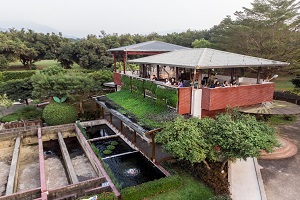
National Pingdong University of Science and Technology workers converted the office space in the sewage treatment site, growing rain water collecting plants, beautiful and environmentally friendly. |
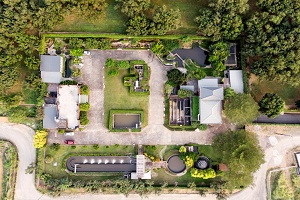
Now the sewage treatment plant is converted into a beautiful garden. |
As for the low-pitched noise emitted from the treatment engines, the sewage treatment process was enhanced through the replacement of equipment and optimization of the treatment procedures. "The environment now is no longer noisy. Instead, what we hear is a pleasant sound of water, and the engines look like ornamental fountains." Zhang said.
An inviting rest area was also created in the Center in order to make the working environment more pleasant. At that time, staff at the Center also took the initiative to use wood discarded around the school to design a wood-themed rest area around the office. The wooden columns are now decorated with crafts made by the staff and small plants. Now, the workers feel like they are working in a garden. This successful transformation proves that as long as we are willing to use our heart, even spontaneous transformation initiated by workers can significantly improve the working environment.
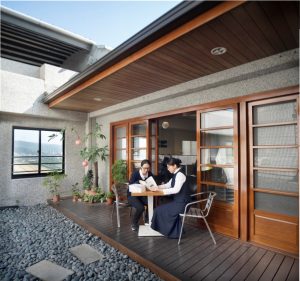
Tzu Chi Jingsi bookstore office open air patio. Situated on the 14th floor overlooking Guandu (關渡) district, this office exudes a homey ambiance.
Treating the office as a "home"
Since Taiwan started developing the industrial and commercial enterprise, the office has almost become a second home for the majority. However, according to the latest statistics, office workers self-assess that the average daily “actual work time" is 8.74 hours, with 29.3 percent of their work days exceeding ten hours. In addition, 45 percent of office workers rated their physical and mental health status as "unhealthy". Recently, there have been many studies showing how the office space has a significant impact on worker job satisfaction, performance, well-being and health.
The transformation of an office is actually the same as the renovation of an old house. It is not necessary to spend exorbitant fees to overhaul everything. Sometimes, just improving the air ventilation, adjusting the lighting, or even the mere act of opening the windows to allow air flow will suffice. If we can introduce seemingly simple changes that enhances the users’ satisfaction, to recreate the working environment like a home, we can substantially improve workers’ physical and mental health, and thus their work engagement and motivation.
Though luxury and high-end offices are attractive to many, what's more important is how to enable employees to positively engage with the working environment. The International WELL Building Institute provided an important definition for architecture four years ago, explaining that while function is the basic value of the existence of a building, the user experience is ultimately what matters most in the design process. This may be the best guiding principle to note as we transform the office environment.
Contact Us | Plan a Visit | Donate
8 Lide Road, Beitou 11259, Taipei, Taiwan
886-2-2898-9999
005741@daaitv.com
©Tzu Chi Culture and Communication Foundation
All rights reserved.

